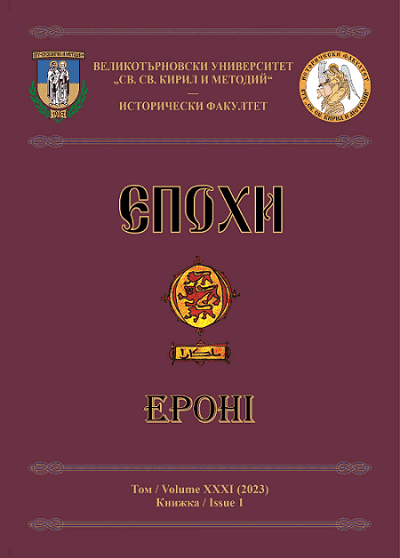The Beginning of the Wallachian Chancery and the Succession to the Throne: Princely Charters and their Diplomatic Formulae from 𝑆𝑎𝑛𝑐𝑡𝑖𝑜 and 𝐷𝑖𝑠𝑝𝑜𝑠𝑖𝑡𝑖𝑜
The Beginning of the Wallachian Chancery and the Succession to the Throne: Princely Charters and their Diplomatic Formulae from 𝑆𝑎𝑛𝑐𝑡𝑖𝑜 and 𝐷𝑖𝑠𝑝𝑜𝑠𝑖𝑡𝑖𝑜
Author(s): Liviu Marius IlieSubject(s): History, Diplomatic history, Political history, Middle Ages, 13th to 14th Centuries, 15th Century
Published by: Великотърновски университет „Св. св. Кирил и Методий”
Keywords: diplomatics; Wallachia; charter; throne succession; sanction; Mircea the Elder (Mircea cel Bătrân)
Summary/Abstract: During the reign of Mircea the Elder (ca. 1386–1418), the Wallachian chancery had an important activity, with many charters from that period reaching modern times; the diplomatic formulae used in composing these documents can explain various cultural and political issues regarding medieval Wallachia. The succession to the throne was a main concern for Mircea; at the end of the charters, very often in sanctio and rarely in dispositio, scribes added different fragments that mentioned the possible successors to the throne (sons, relatives, or pretenders from other families). The evolution of these diplomatic formulae is more explicit by considering the beneficiaries of the charters, especially the monasteries of Tismana and Cozia. Moreover, an analogy with the Bulgarian chancery can reveal interesting conclusions.During the reign of Mircea the Elder (ca. 1386–1418), the Wallachian chancery had an important activity, with many charters from that period reaching modern times; the diplomatic formulae used in composing these documents can explain various cultural and political issues regarding medieval Wallachia. The succession to the throne was a main concern for Mircea; at the end of the charters, very often in 𝑠𝑎𝑛𝑐𝑡𝑖𝑜 and rarely in 𝑑𝑖𝑠𝑝𝑜𝑠𝑖𝑡𝑖𝑜, scribes added different fragments that mentioned the possible successors to the throne (sons, relatives, or pretenders from other families). The evolution of these diplomatic formulae is more explicit by considering the beneficiaries of the charters, especially the monasteries of Tismana and Cozia. Moreover, an analogy with the Bulgarian chancery can reveal interesting conclusions.
Journal: Епохи
- Issue Year: XXXI/2023
- Issue No: 1
- Page Range: 97-101
- Page Count: 5
- Language: English, Romanian

